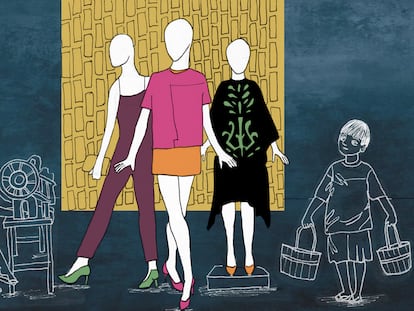Tailoring rebellion: British fashion confronts Brexit with commercial counterculture offerings
At London Fashion Week, designers combined avant-garde and realism, rebellion and entrepreneurial drive, amid a crisis in the textile industry
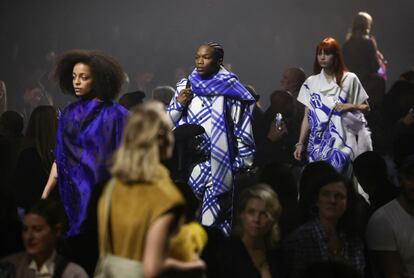
In an interview with The Guardian a few days ago, designer JW Anderson warned that British fashion is at risk of disappearing amid what he described as a post-Brexit “paralysis,” and called for the industry to “step up and say something.” Indeed, according to data from the UK Fashion and Textile Trade Association, 98% of British fashion businesses faced high administrative costs in 2021, 83% had to increase the prices of their garments and 53% had several of their orders held up in customs. According to a 2020 report by Oxford Academics and the British Fashion Council, British fashion generates around £30 billion (about $36 billion). That’s more than what the music or film industries bring in. Now, however, its place in the global industry is threatened.
London Fashion Week, which began last Friday and ended on Tuesday of this week, was two days shorter than usual this year. Some designers, most of them financially and logistically supported by the British Fashion Council (the government agency that promotes signature local fashion), such as KNWLS, Masha Popova and Rejina Pyo, did not present collections at all. This year’s London Fashion Week was dedicated to the late Vivienne Westwood, who died last December. She was a designer who first channeled discontent and social anger into punk aesthetics and then into climate activism.
Anderson wanted to convey precisely that idea of fashion as a means of rebellion in his fashion show last Saturday. The Roundhouse, a Camden venue known for raves and shows, served as the setting for a collection inspired by the work of choreographer and artist Michael Clark. “Over these 15 years, I have realized that Clark has inspired each and every one of my collections,” Anderson explained prior to the show. Thus, Anderson, who is also the artistic director of Loewe, showcased styles that paid homage to some of his own past successes (large-lapel coats, ruffled masculine shorts, structured knit dresses, sailor shirts) and combined them with the iconoclastic boldness of the Clark-influenced pieces in his work, such as a dress inspired by Tesco supermarket bags, sweaters that read “witch” and “alpha male” and the enormous penis used as a backdrop of the show.
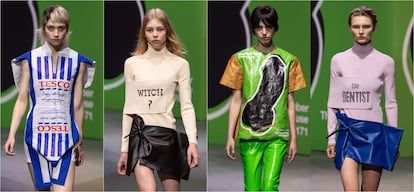
For half a century, rebelliousness and avant-garde styles have been classic features of the fashion that the UK has exported around the world. But even more important than these elements is the distinctly British style that defines the United Kingdom in the collective imagination. In his long-awaited first collection for Burberry – the quintessential British fashion house – designer Daniel Lee returned to this concept. In the six years that designer Italian Riccardo Tisci was at the helm of the brand, Burberry turned, with relative success, toward the macro trend of urban fashion. But Lee’s first fashion show was a statement of intent. It took place in a tent in Kennington Park that simulated one in the countryside. There, the guests – who were given blankets and hot water bottles printed with the house’s signature check pattern – saw that Burberry had returned to its roots, as imagined by Lee, the man who turned classic Bottega Veneta shows into viral events over the past few years.
This collection featured wellies, suede trench coats lined with sheepskin, duck prints, wool – in short, all the elements that define the English aesthetic, all in the designer’s favorite colors (green, purple and yellow). They were paired with items that showcased Lee’s talent for turning accessories into cult pieces: Clarks-style suede shoes with exposed seams, quilted boots and furry bags that close with a B adorned by another very English element: the (fake) foxtail.
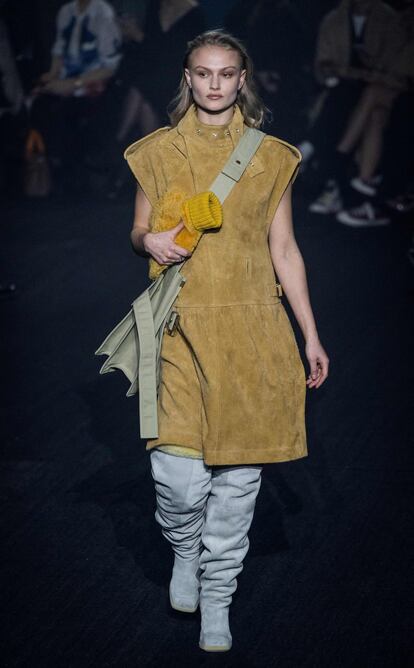
Self-reference is also a recurrent theme of many Christopher Kane collections. The British designer usually takes a decontextualized element and deconstructs it throughout his collections. On this occasion, ruffled frills decorated the creator’s favorite garments, from suits to very long-sleeved sweaters to latex skirts. The collection redounded to Kane’s identity with a mix of knitwear and sequins, vinyl and wool, necklines and decontextualized finishes, but they were all more basic and commercial than usual.
These days, that has been the general tone of the fashion shows in London (as well as those at New York’s fashion week): many designers have decided to ground their creative concepts and offer more realistic collections than they usually do. For instance, Simone Rocha’s nineteenth-century fantasies, presented in the dramatic setting of Westminster Hall, were mixed with the much more urban aesthetic of bomber dresses, leather frock coats and flowing lace garments. Similarly, Richard Quinn, who is famous for fusing romanticism and fetishism in his floral print and latex combinations, stopped covering his models’ heads and hands and dispensed with recreating Victorian styles. This time, his dresses were made of precious fabrics studded with rhinestones and adjusted to the body in almost natural proportion. Bridal gowns, the designer’s most realistic commercial option, represented a third of the collection.
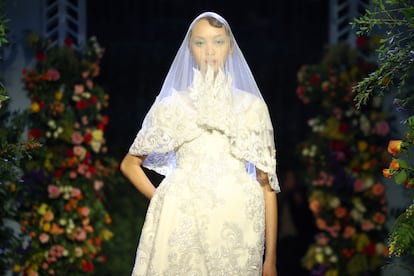
Small cult brands, such as Chet Lo, Harri and Nensi Dojaka, also tried to add commercial appeal to their signature styles. Chet Lo featured basic dresses, sweaters and sweatshirts in its characteristic spike-knit fabric. Harri, which recently went viral after singer Sam Smith wore its clothing at the Brit Awards, showcased its signature puffy vinyl style in jackets and coats. And, for the first time, Nensi Dojaka paired its famous transparent pieces replete with straps with jeans and blazers, suggesting that the brand’s fashion can transcend catwalks and red carpets. Even S.S. Daley, the brand new LVMH award winner, eschewed the customary small plays with which he normally presents his collections in favor of a traditional fashion show, which was inspired by sailor-style clothing and opened by actor Ian McKellen.

During these times of inflation and uncertainty, fashion seems to want to put its outlandish fantasies aside in order to prove that it can be practical and to please consumers who are drawn more to investment pieces than whimsy. Additionally, with Brexit threatening its global survival, British fashion wants to prove that it can blend avant-garde and realism, rebelliousness and commercial appeal.
Tu suscripción se está usando en otro dispositivo
¿Quieres añadir otro usuario a tu suscripción?
Si continúas leyendo en este dispositivo, no se podrá leer en el otro.
FlechaTu suscripción se está usando en otro dispositivo y solo puedes acceder a EL PAÍS desde un dispositivo a la vez.
Si quieres compartir tu cuenta, cambia tu suscripción a la modalidad Premium, así podrás añadir otro usuario. Cada uno accederá con su propia cuenta de email, lo que os permitirá personalizar vuestra experiencia en EL PAÍS.
¿Tienes una suscripción de empresa? Accede aquí para contratar más cuentas.
En el caso de no saber quién está usando tu cuenta, te recomendamos cambiar tu contraseña aquí.
Si decides continuar compartiendo tu cuenta, este mensaje se mostrará en tu dispositivo y en el de la otra persona que está usando tu cuenta de forma indefinida, afectando a tu experiencia de lectura. Puedes consultar aquí los términos y condiciones de la suscripción digital.
More information
Archived In
Últimas noticias
Most viewed
- Sinaloa Cartel war is taking its toll on Los Chapitos
- Oona Chaplin: ‘I told James Cameron that I was living in a treehouse and starting a permaculture project with a friend’
- Reinhard Genzel, Nobel laureate in physics: ‘One-minute videos will never give you the truth’
- Why the price of coffee has skyrocketed: from Brazilian plantations to specialty coffee houses
- Silver prices are going crazy: This is what’s fueling the rally

